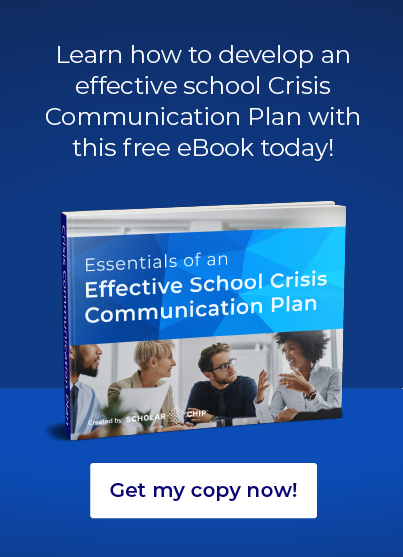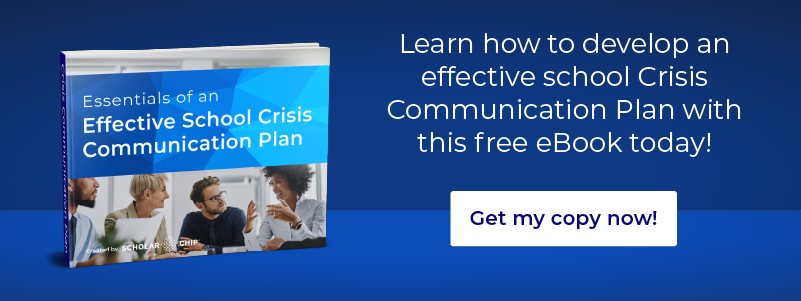News of an approaching winter storm, a bus accident, a gas leak in the neighborhood, or a stranger on school grounds are all things that will cause parents to fear for their children’s safety while they are at school. Failed communications can raise this fear to the level of panic, worsening the situation as anxious parents tie up phone lines or arrive at school buildings en masse to retrieve their children.
Even the rumors of an incident that are spread through social media may cause distress and lead parents to lose trust and question the competency of school leadership. Communication failures also cause delays in emergency response, increasing risks to students and school personnel.
For these reasons, a strong crisis communication strategy is an essential part of a district’s emergency operations plan. New concerns, such as the global pandemic, and changes in technology make old plans unreliable. To be effective, emergency operations plans (EOPs) should be reviewed and updated annually. This process must include assessing the district’s crisis communication strategy to ensure plan components—the who, when, and how—of communications are relevant as technology and a community’s communication habits change.
Step #1: Identify the people involved, such as the planning team and stakeholders.
The US Department of Education advises districts to form a core planning team when creating an EOP. The team needs to be small enough to allow close collaboration, yet large enough to include representatives among parents, first responders, and others in the community.
On this team, the role of communications coordinator is perhaps the most vital. This individual must have a direct line to the school superintendent and is tasked with overseeing that all stakeholders—administrators, faculty, staff, students, first responders, relevant government agencies, parents, and the media—are considered.
Step #2: Identify possible emergencies and communication challenges.
Different crises have different communication needs and challenges. A comprehensive plan must identify possible emergencies and determine the appropriate response for each.
A weather event that demands an early school closing will require a widely broadcast announcement. The news media, social media, and automated phone calls and SMS messaging may be the best ways to inform parents. Built-in redundancies will ensure that everyone gets the message even when power outages or other situations knock out first-line communication methods.
An intruder situation requires a different communication strategy, one that keeps communications open but discreet. Personnel within the building and law enforcement must be kept apprised of the situation without creating community panic or tipping off the intruder to law enforcement’s position. During fires, bomb threats, and other emergencies that require building evacuation, school leaders and first responders need systems that will let them know when all building occupants have been safely evacuated and who may be missing from the headcount.
Health emergencies, something that has taken center stage in 2020 with the COVID-19 pandemic, require coordinating information from the school health office, attendance records, and local health departments. Schools must keep parents up to date on any health concerns within the district, whether it’s regarding head lice or a norovirus outbreak. Threats such as a nearby criminal activity or shootings and hazardous materials spills will also require situation-specific communication protocols.
Step #3: Determine where stakeholders may be reached.
During the school day, teachers may be in the classroom or in group gathering areas, such as the library, the cafeteria, or the playground. Building administrators may be in their offices or attending to school business elsewhere. Parents may be at home, at work, or somewhere else in the community. Identify where stakeholders may be reached to inform the next step, which requires listing the most effective modes of communication.
Step #4: List effective communication methods.
Half the homes in the country no longer have landlines; many people now depend on social media for news and information. Smartphones have changed how and how often people connect to the internet. Recognize these trends when determining the best ways to reach stakeholders during a crisis. Mobile technology and auto-messaging capabilities have made it possible to reach all stakeholders simultaneously. For less urgent communications, send home notices with students, emails, and social media/website posts.
Step #5: Develop message protocols and procedures.
Pre-written messages for the most likely emergencies will save the communications coordinator time and ensure that the message is clear, not hastily written. Planners should also create rules for issuing alerts so the communication coordinator has a standard to follow when determining if an event is an actual crisis that should trigger emergency protocols. Procedures for issuing emergency messages should follow a set order, similar to a phone tree, so individuals in the communication chain understand their duties.
The ubiquitous use of social media makes it a logical method for quickly reaching a large, targeted audience. However, social media posts can create confusion and panic. The NEA suggests that planners create an “if this, then that” flowchart to determine if an event has reached a level that requires a social media response. As with all communications, social media posts must follow content guidelines to ensure that posts are appropriate and properly tagged.
Step #6: Assess current capabilities.
Disparate legacy systems may leave communication gaps. SIS, administration software, and attendance records data tend to be siloed, making it difficult to know who is in the building in real time. Matching students with their current contact information is slowed in outdated systems. Internal communication systems that rely on two-way intercoms or pagers present difficulties when a teacher needs to send a private communication to the office.
External communications to first responders, parents, the public, and the media may rely on landlines or internet connections that could be disrupted during a severe weather event. Aging hardware, such as two-way radios and PA systems, may be failing. An inventory of all hardware will reveal weaknesses in the district’s communication systems.
Step #7: Explore new technologies to strengthen a crisis communication strategy.
Part of a strong crisis communication strategy is its technology. Automated attendance and visitor management systems allow school personnel to know who is in the building at any time, which is critical information during an emergency. Integration of SIS, administration software, attendance, and health office records facilitate communications by ensuring relevant information, such as contact phone numbers/email addresses and daily attendance, are accessible in one place. With newer IT systems, all data may be accessed from a central hub. Data stored off-site will be available from remote locations and not threatened by possible damage to school servers.
An EOP is only as strong as its communication capabilities. Detailing who must be informed and when emergency messages are necessary and selecting effective modes of communication will eliminate much of the chaos that comes with a crisis. Updated, integrated IT systems can streamline communication systems and improve operational efficiencies throughout a district. Contact ScholarChip to learn about innovations in technology that will strengthen your school’s crisis communication strategy.
Here at ScholarChip, we’re dedicated to helping school leaders maximize the safety and well-being of students and the entire school community.
Want to develop an effective school crisis communication plan but not sure where to start? Feel free to chat with one of our school crisis communication specialists today!


